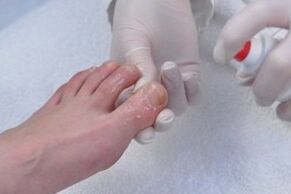
Fungal disease of the nails is called onychomycosis, and it is caused by pathogenic fungi (dermatophytes).
Most often, the fungus affects the nails, less often - the skin. Infected with onychomycosis mainly people who lead a healthy lifestyle - in the swimming pool, sauna, on the beach.
The symptoms of onychomycosis should not be confused with anything, because the nails go from shiny and smooth to cloudy, rough and thickened. Yellow, gray, brown spots appear on it, as well as stripes or dents. The skin around the nail becomes inflamed and swollen. Nails can peel and crumble, and are sometimes left behind on the nail bed.
Nail fungus treatment
Detecting fungal diseases is easy, but it is more difficult to get rid of them. The treatment process is difficult and requires a lot of time and patience. The first results of therapy appear no earlier than 2 weeks after the start of treatment, and the entire period takes from 6 to 12 months.
The danger of fungal infections on the nails is that when the immunity of the disease decreases, allergic reactions appear, and chronic diseases become worse.
Fungal disease therapy is different, and depends on the area affected by the fungus and its type. Combination therapy is most often used, when drugs for internal use and local antifungal agents are combined.
Preparations for local therapy are different, but one of the most effective is antifungal varnish, which covers the diseased nail. Other topical medications can be used on the skin.
Steps to prevent fungal nail infections
According to statistics, 20% of the world's population suffers from fungal diseases, so it is important to follow disease prevention and self-protection measures.
Effective preventative measures include the following:
- Before visiting a public recreation area, treat your feet with antifungal ointment or any local medicine.
- After visiting the swimming pool or sauna, treat your feet and hands with a salt solution or bathe with 72% laundry soap.
- Wear comfortable shoes, and monitor sweaty feet so conditions are not created for the growth and development of fungal infections.
- Follow the rules and norms of personal hygiene (individual use of shoes, slippers, underwear).
- Do not walk on the beach barefoot, but wear light shoes.

















